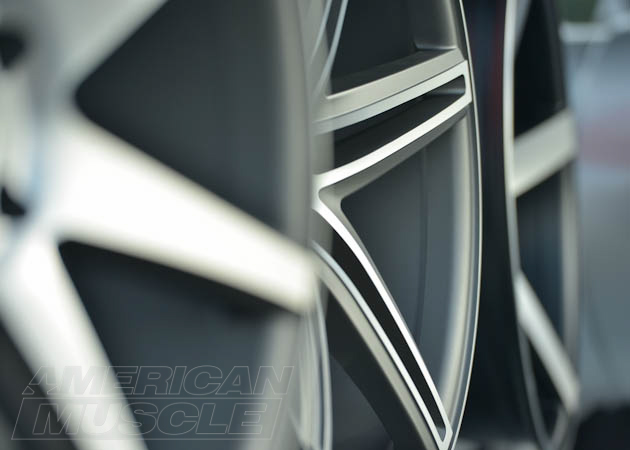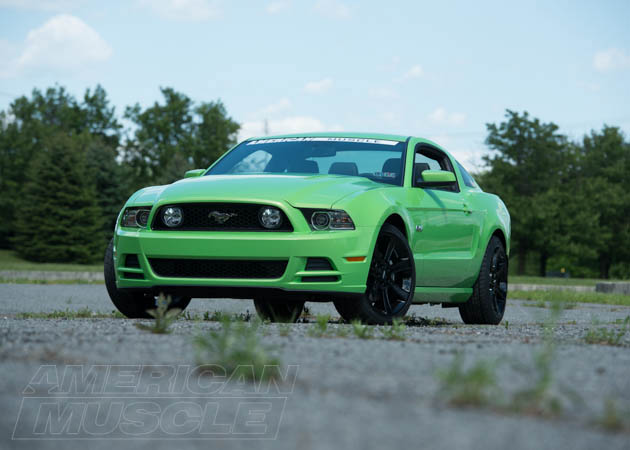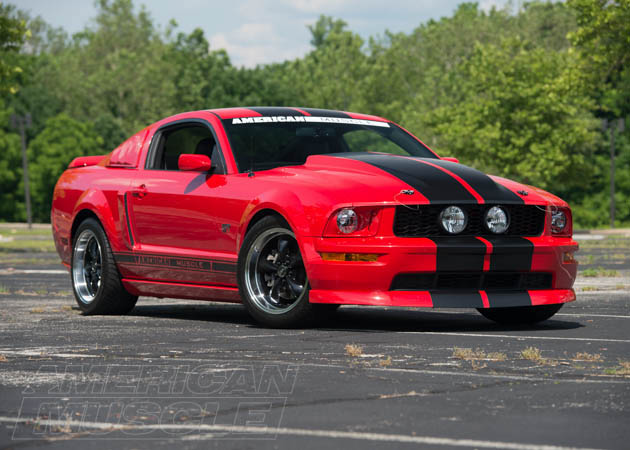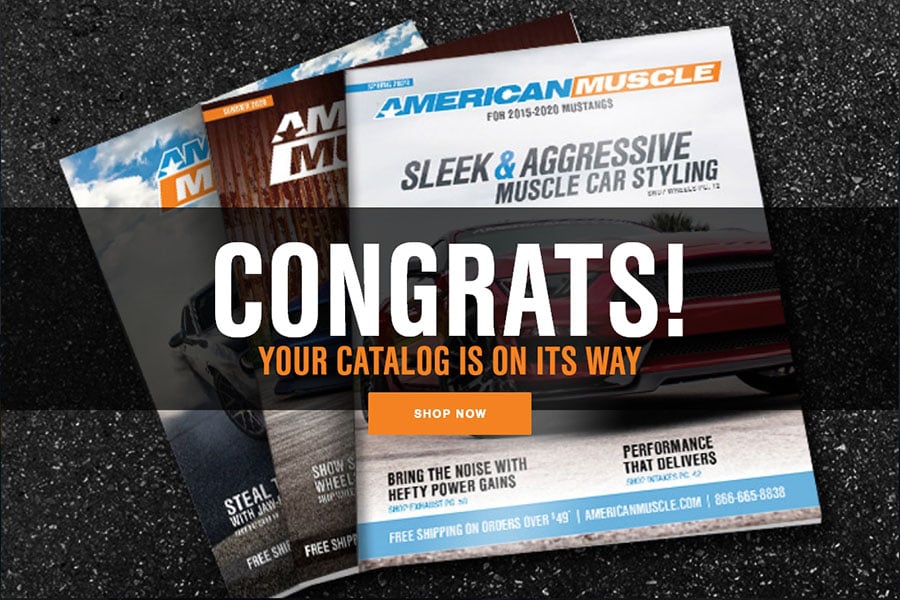The wheels and tires are the backbone of any car’s appearance, and this is no different for the Ford Mustang. Aside from setting the tone for your aesthetic, upgrading your Mustang’s wheels and tires also can provide you with improved traction and handling. This guide will briefly go over some of the key points to upgrading your wheels and tires and what you stand to gain.
Shop Mustang Wheels
Putting larger tires on your Mustang first requires bigger rims. Get the traction and control your Mustang needs by throwing a wider set of tires.
Shop Wheels
Why You Should Upgrade Your Factory Mustang Wheels & Tires
Upgrading the wheels and tires of your Mustang will:
- Improve overall appearance
- By upgrading to a wider tire, you’ll be giving your Mustang better traction to tackle corners and grip the road while accelerating
- A staggered setup can lead to better traction and better performance and handling
- In addition to upgrading your tires, also upgrading your wheels will provide performance and handling advantages that complement a larger tire
To think about it in the simplest of terms, the wheels and tires are what connects your Mustang to the pavement; all the power your pony makes has to be transferred through the wheels and tires. Power aside, all of your Mustang’s body weight is balanced and controlled by the wheel and tire setup you run.
Your brakes can only stop your Mustang as well as the tires will allow as braking does require traction. Essentially, your wheel and tire setup will make or break your build in more ways than one, which is why it is important to spare no expense on your setup.
Benefits of Aftermarket Mustang Wheels
Wheels are much more than just an aesthetic upgrade; while they do set the tone for your Mustang, they can also offer you performance benefits. The biggest performance gain you can get from a set of aftermarket wheels is reducing the overall weight/rotating mass at all four corners.
Although it may seem trivial to some, or even a minor upgrade, but reducing wheel weight can have large impacts on track times. Looking at the GT350 vs the GT350R, the latter using lightweight carbon fiber wheels that weigh in at only 18 lbs, the GT350R competed back to back on the same track as a GT350 and ran a 2 second faster lap time which was credited to the R’s lightweight wheel setup.
Benefits of Aftermarket Mustang Tires
Tires are arguably the most important upgrade you can make to your Mustang. Bar none. It doesn’t matter if you have a daily driver that you only drive on Sundays, a dedicated drag car, or a weekend warrior you run in autocross and HPDE races. Tires are the most important upgrade and can have one of the largest impacts on your Mustang’s performance.
When it comes to drag racing, a set of drag tires will provide you with the maximum of traction your suspension system can support off the line as they are designed to be soft and ripple when launching for grip. When it comes to road racing/autocrossing, a set of performance tires will afford you with drastically increased grip in lateral maneuvers and give you the footing you need to whip around the course. For daily driving, a good set of tires will provide you with a good mix of grip off the line, in the corners, and in inclement weather; daily driver tires tend to be more of a jack of all trades than a master of one, which is exactly what you want as you never know what you may encounter.
A Standard or Staggered Setup on Mustangs
When looking through your tire/wheel choices, you’ll notice there is usually a choice for going with a staggered setup. This means the rear tires will be wider than the front tires. Ford sticks to the same size all around to make it easier to build and service the Mustang, but you can gain performance by going with a staggered setup. On a high powered rear wheel drive car like a Mustang, getting wider rear tires can be a real help. The more tire contact equals better traction which in turn yields more useable power to the ground, propelling you forward.
Some people prefer to stay with a standard setup because they want to retain the ability to rotate their tires for better wear management. The counterpoint is larger rear tires will last longer because they’re not being overpowered as much. Another concern people bring up is a staggered setup could make your Mustang understeer. This could be a concern if you were leaving your front tires stock. As long as you’re upgrading all four tires, a staggered setup is still going to significantly improve handling overall.
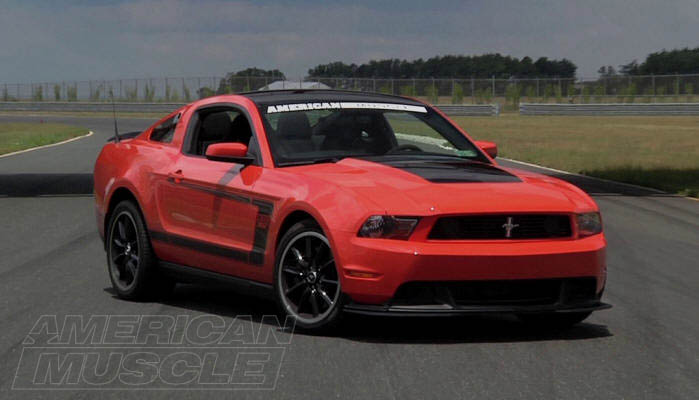
Bosses Came Factory with Staggered Setups
Shorter Sidewalls = Less Flex
Besides increasing tire width, another major reason for upgrading is to get larger diameter wheels. An obvious reason for this is because they look better, but larger wheels can also improve handling. When you change out your wheels and tires, you want the total diameter to remain the same. The larger the wheel, the shorter the sidewall on the tire becomes to compensate. Shorter sidewalls don’t flex nearly as much as larger sidewalls during cornering, which results in a more precise handling and better steering feel.
Drag Wheel & Tire Fitment
One of the most important parts of racing is your tires. Drag set-ups are a little more complicated than a regular wheel and tire set up, especially when it comes to fitment. So here is a quick guide of what to remember and think of when you're looking at converting your road pony to a dragster.
- All Mustangs will require a lug nut upgrade for drag wheels
- Your Mustang can not be lowered more than 2" from factory height
- If you have suspension modification, you might run the risk of rubbing against the new set-up
- For cars with big brake packages no matter what the year, will have to make sure they have the proper clearance up front and in the rear for these wheels
- Drag wheels are also very specific to what year Mustang you have
- 2015 Mustangs will need at least a 17" wheel in the front or back and cannot be any smaller
- 2005-2014 Mustangs can run a 17" drag wheel on the front or back with no issues or a 15x8 and skinnier as well in the rear of the car. However, in order to run a 15x10" wheel in the rear, you'll need sway bar relocation brackets. This will relocate the sway bar so the wheel will not rub into the factory sway bar location. This modification will require you to grind down your factory sway bar mounts
- 1994-2004 Mustangs can run any size drag wheel designated for that year range. You'll just need the lug nut upgrade kit specified for your model year
- 1979-1993 Foxbodies only have one type of drag wheel available it will work fine without any modifications as long as the car is at factory height. Any lower and you'll run their own risk of rubbing or fitment issues. Generally, no more than 1.5" of a drop is acceptable
Picking Out The Right Wheel & Tire Setup For Your Mustang
To select the perfect setup for your ‘Stang, you will need to consider:
- What your budget is
- What your goal with the is
- How often will your Mustang see bad weather
- What “look” you are going for
Wheel and tire setups can be incredibly subjective and hard to make a definitive decision on. It’s best to get a few options together and then research them all extensively, talking to everyone from forum members to your friends.
Stock Wheel and Tire Sizes by Mustang Year
| Year/Sub-Model |
Wheel Size |
Tire Size |
| 1979-1989 GT |
15x7 |
225/60/15 |
| 1979-1986 LX |
14x6 |
195/75/14 |
| 1987-1993 LX |
15x7 |
195/75/15 |
| 1990-1993 GT |
16x7 |
225/60/16 |
| 1993 Cobra |
17x7.5, 17x8 |
245/45/17 |
| 1994-1995 Cobra |
17x8, 17x9 |
255/45/17 |
| 1994-1995 GT |
16x7.5/17x8 |
225/55/16 |
| 1994-1995 V6 |
15x6.5/15x7 |
205/65/15 |
| 1996-2004 GT |
17x8 |
245/45/17, 225/55/17 ('98 Sport Package) |
| 1996-2001 V6 |
15x6.5/16x7.5 |
205/65/15, 225/55/16 |
| 1996-1998 Cobra |
17x8 |
255/45/17 |
| 2000 Cobra |
18x9.5 |
265/40/18 |
| 2001 Cobra & Bullitt |
17x8 |
245/45/17 |
| 2002-2004 V6 |
16x8 |
225/55/16 |
| 2003-2004 Cobra & Mach 1 |
17x8 |
275/40/17 |
| 2005-2009 GT |
18x8 |
235/50/18 |
| 2005-2009 V6 |
17x8/16x7.5 |
235/55/17, 215/65/16 |
| 2007-2009 Shelby |
18x9.5 |
245/45/18 (front), 285/45/18 (rear) |
| 2008 Bullitt |
18x8.5 |
| 2010-2014 GT |
18,19, or 20x8 |
255/35/20, 245/45/19, 235/50/18 |
| 2010-2014 V6 |
17x8/18x8 |
235/50/18, 215/60/17 |
| 2010-2012 Shelby |
18x9.5, 19x9.5 |
255/40/19 (front), 285/35/19 (rear) |
| 2010-2012 Boss |
19x8.5 |
| 2011-2014 w/ Brembos |
19x9 |
255/40/19 |
| 2013-2014 Shelby |
19x9.5 (front), 20x9.5 (rear) |
265/40/19 (front), 285/35/20 (rear) |
| 2013-2014 Boss |
19x8.5 |
| 2015-2017 GT |
18x8 |
235/50/18 |
| 2015-2017 V6 EcoBoost |
17x7.5 |
235/55/17 |
| 2015-2017 w/ Brembos (GT) |
20x9, 19x9, 19x9.5 |
265/35/20, 275/35/19, 255/40/19 |
| 2015-2017 w/ Brembos (V6 EcoBoost) |
18x8 |
|
Fitment includes: 1979, 1980, 1981, 1982, 1983, 1984, 1985, 1986, 1987, 1988, 1989, 1990, 1991, 1992, 1993, 1994, 1995, 1996, 1997, 1998, 1999, 2000, 2001, 2002, 2003, 2004, 2005, 2006, 2007, 2008, 2009, 2010, 2011, 2012, 2013, 2014, 2015, 2016, 2017, 2018, 2019, GT, V6, Cobra, ShelbyGT500, Mach1, Bullitt, Boss, LX, SVO, EcoBoost, ShelbyGT350

